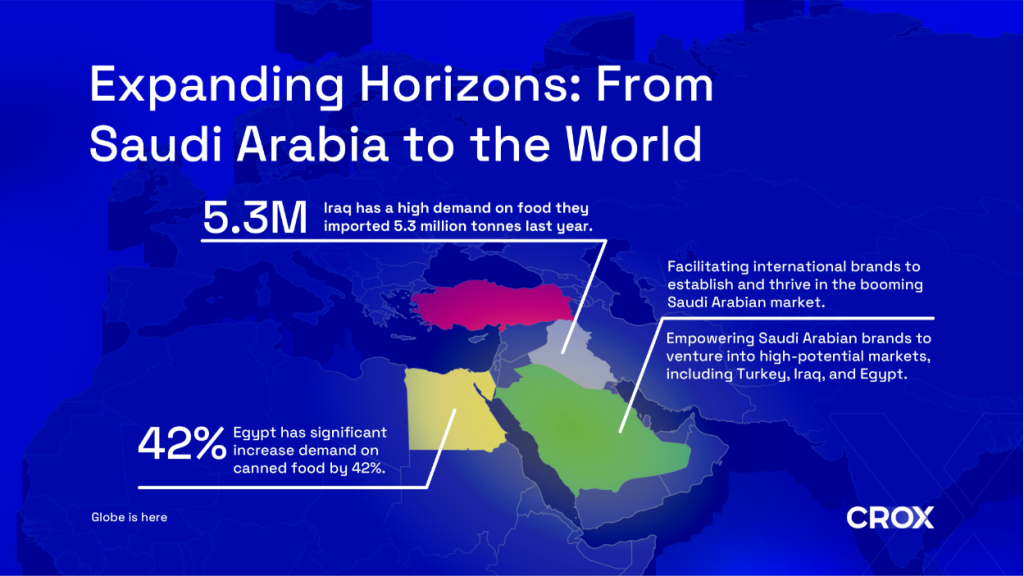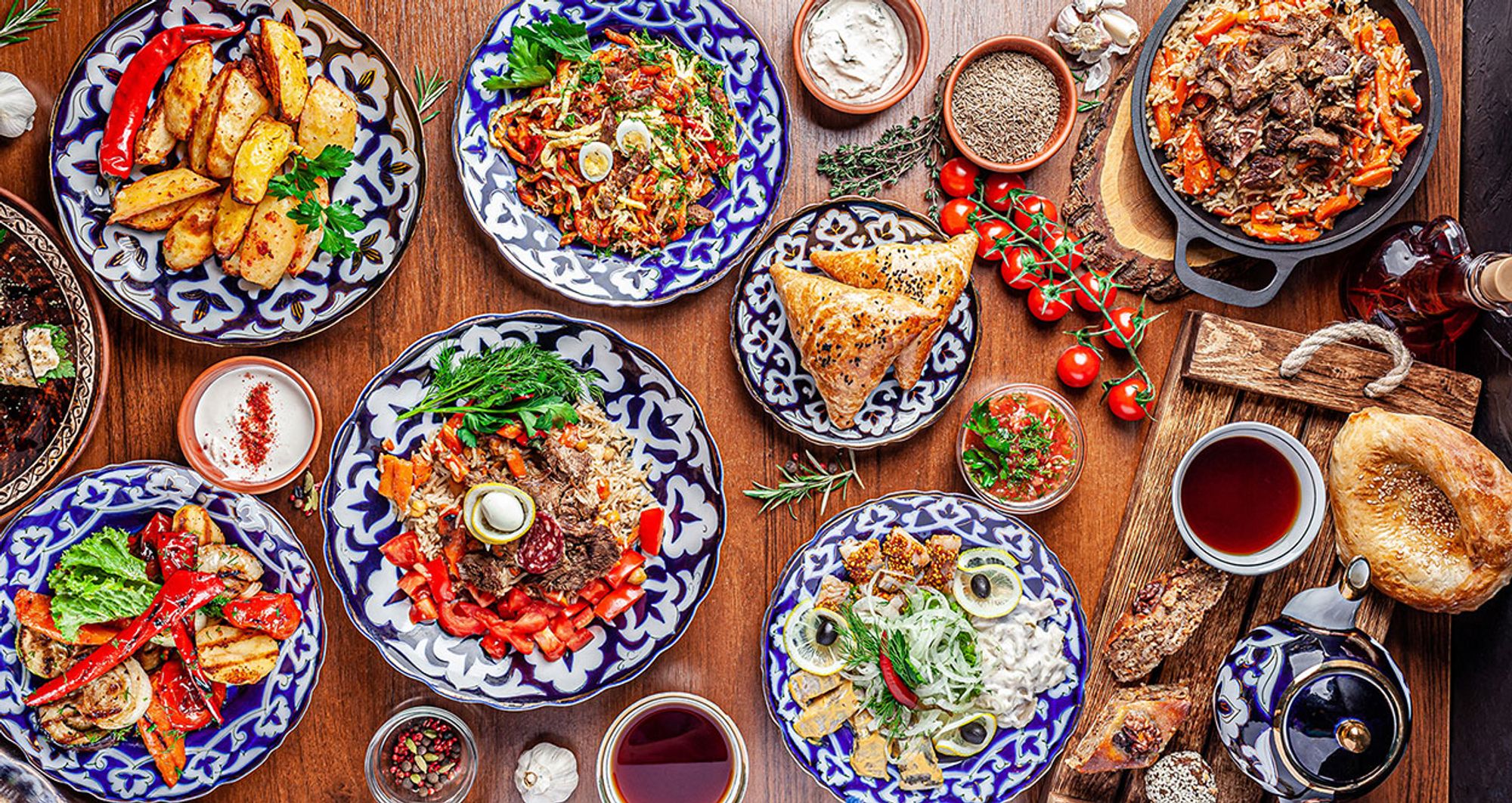The Middle Eastern food market is simmering with potential, set against economic turbulence and rising food inflation, which casts a shadow over household spending and long-term food security. Yet, within this complex landscape, the fast food market stands as a beacon of growth, with expectations to swell from USD 39.54 billion in 2024 to USD 44.52 billion by 2029. This growth is paralleled by a burgeoning trend towards plant-based diets and sustainable eating, signaling a shift in consumer preferences that marries health consciousness with environmental stewardship. As we navigate the intricacies of these markets, we uncover the resilience and adaptability of a region rich in culinary heritage yet poised on the cusp of gastronomic innovation. (source)
Overview of Food Market Growth
Food is the ingredient that binds us together
A sentiment echoed by culinary enthusiasts around the globe is vividly manifested in the bustling food markets of the Middle East. This region, rich in history and culture, presents a culinary landscape as diverse and vibrant as its people.

In Saudi Arabia, the fusion of traditional and global flavors tells a story of a nation at the crossroads of change. The kingdom’s culinary scene has expanded beyond its borders, embracing global cuisines while staying true to its roots. A visit to Riyadh’s Al-Nakheel, with its modern twist on traditional dishes, reflects the country’s evolving palate and openness to global culinary influences. As of the latest data, the food and beverage sector in Saudi Arabia is projected to grow by 6% annually, reaching a market volume of US$45 billion by 2025, underscoring the rapid expansion and diversification of the kingdom’s culinary industry.
Turkey’s culinary heritage, steeped in the legacy of the Ottoman Empire, is being redefined by chefs blending ancient recipes with modern sensibilities. The streets of Istanbul are a testament to this culinary diversity, where traditional eateries and modern restaurants co-exist. Unlike Mikla, known for its innovative approach to Turkish dishes, places showcase the balance between preserving tradition and embracing contemporary trends. The restaurant industry in Turkey has witnessed a growth rate of approximately 10% in recent years, with Istanbul hosting over 20,000 restaurants, reflecting the city’s dynamic and evolving food scene.
Egypt offers a canvas of ancient flavors painted with modern strokes. The bustling streets of Cairo, lined with vendors offering traditional dishes, also house cafes and restaurants that reinterpret these classics for today’s diner. Zooba, with its contemporary take on Egyptian street food, stands as a beacon of the country’s dynamic food scene, marrying the old with the new in every bite. The street food market in Egypt is a significant part of the economy, contributing to over 40% of the country’s food and beverage industry revenue, highlighting the enduring popularity and innovation within Egypt’s culinary sector. Amidst this vibrant food culture, there has been a notable shift in consumption patterns, with a 42% increase in canned food consumption among Egyptians. This surge reflects a growing trend towards convenience without compromising on the taste and quality of traditional flavors, further illustrating the Egyptian food market’s adaptability and resilience.
Decoding Middle Eastern Palates
“A dish without spice is like a day without sunshine.” This adage resonates profoundly in Saudi Arabia, where an inherent affection for sumptuous, spice-laden meals is now enriched by an eagerness to embrace international culinary currents. The kingdom is witnessing an exciting phase with the arrival of global restaurant chains and a notable pivot towards healthier eating alternatives, showcasing a sophisticated palate that reveres the richness of Saudi gastronomy yet seeks novel taste adventures. This harmonious fusion of the old and the new in Saudi dining preferences paints a picture of a culinary landscape that is as lively and evolving as the sands of the desert.
“Coffee should be black as hell, strong as death, and sweet as love.” This adage perfectly captures the quintessence of Turkish culinary ethos, where the symphony of bold and sweet orchestrates the dining experience. Turkish palates are discerning, with a deep appreciation for the grandeur of Ottoman culinary history as well as a keen interest in contemporary dietary trends like plant-based nutrition and the craft coffee movement. The emergence of farm-to-table venues across Turkey heralds a shift towards sustainability and authenticity, marrying the revered traditions of the past with the innovative practices of the present, in every morsel.
“The mouth eats, but it’s the heart that gets satisfied.” Egyptian cuisine embodies this philosophy, offering dishes that are as rich in flavor as they are in cultural significance. Classics such as koshary and ful medames continue to anchor the culinary scene, yet there’s an escalating demand for international flavors and healthier choices. Egypt’s dynamic street food culture, now side by side with a curiosity for global dishes, reflects a nation grounded in its culinary roots yet eager for gastronomic exploration, indicating a society dining to enrich both body and soul.
“Food is a bridge that connects people.” Nowhere is this more evident than in Iraq, where culinary traditions not only survive but thrive amidst the country’s journey towards renewal. From the cherished masgouf to contemporary eateries offering a world of flavors, Iraq’s food landscape is a vibrant showcase of resilience and heterogeneity. The resurgence of age-old Iraqi dishes, coupled with the embracement of new global tastes, narrates a story of a society that honors its gastronomic legacy while welcoming the winds of change. The increasing allure of cafes and informal dining in cities like Baghdad and Erbil signals a vibrant food market, ready to embark on new gastronomic adventures, bridging hearts one dish at a time.
Taste Horizons
The transformation of eating habits, marked by an increasing embrace of fast and health foods, mirrors a broader lifestyle evolution across the Middle East. With Saudi Arabia at the forefront, the health food sector is expected to witness a 7% annual growth, highlighting a trend towards integrating global culinary innovations with traditional flavors. This shift indicates a complex palate that appreciates the depth of local gastronomy while venturing into new taste territories.
Amidst this evolving landscape, Turkey’s dedication to organic and artisanal products is gaining momentum, driven by consumer demands for transparency and quality in their food sources. This movement is not just a trend but a significant shift, with the organic sector anticipated to grow annually. A food industry analyst optimistically notes, “The organic food movement will significantly impact Turkey’s culinary identity, both at home and abroad,” suggesting a transformative effect on Turkish cuisine’s domestic and international perception.
Similarly, Egypt’s culinary scene is characterized by a vibrant street food culture and a penchant for local delicacies, underscoring a deep-seated cultural phenomenon. The sector’s enduring appeal to both locals and tourists is expected to fuel a 10% growth in the street food market over the next year. This reflects not only a culinary preference but a broader cultural heritage that continues to thrive in the modern era.
In Iraq, the resurgence of traditional foods coupled with the burgeoning popularity of modern cafes illustrates a nation’s journey towards culinary rejuvenation. The modern cafe scene, in particular, is expected to grow by 15%, showcasing a society that values its historical dishes while embracing new, innovative dining experiences. A culinary expert comments, “Iraq is on a path to culinary rediscovery, blending its historical dishes with new, innovative dining experiences,” highlighting the dual trends of tradition and innovation fueling the country’s food industry growth.
This panoramic view of the Middle Eastern culinary landscape reveals a region at the crossroads of tradition and modernity, where the rich tapestry of flavors continues to evolve, propelled by changing consumer preferences and a growing appreciation for both heritage and innovation in food.
The Middle East’s culinary scene, with its mix of tradition and innovation, reflects a region that’s constantly evolving while staying rooted in its heritage. It’s a reminder that food is more than just sustenance; it’s a celebration of culture, history, and the endless possibilities of creativity. As we step away from the bustling markets and quiet kitchens, we carry with us the essence of the Middle East — a flavor of adventure that lingers long after the journey ends.
From Cairo’s lively streets to Riyadh’s elegant eateries, the Middle East is exploring ways to keep its food traditions alive while cutting down on waste. This new focus shows us that food in the Middle East is not just about tasting something delicious; it’s about sharing, caring, and making sure there’s enough for everyone, showing us a different side of its culinary culture.

